In providing a broad overview of the hundreds of distinct American Indian cultures found in North America, it is common for museums, historians, archaeologists, and ethnologists to use a culture area model. This model is based on the observation that different groups of people living in the same geographic area often share many cultural features.
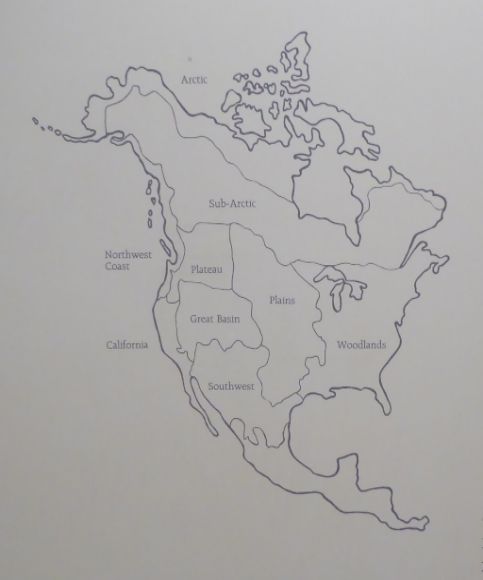 The map shown above shows the primary North American Indian culture areas.
The map shown above shows the primary North American Indian culture areas.
The Plateau Culture Area is the area between the Cascade Mountains and the Rocky Mountains in Washington, Oregon, Idaho, British Columbia, and Western Montana. From north to south it runs from the Fraser River in the north to the Blue Mountains in the south. Much of the area is classified as semi-arid. Part of it is mountainous with pine forests in the higher elevations.
 The shaded area on the map shown above designates the Plateau Culture Area.
The shaded area on the map shown above designates the Plateau Culture Area.
While much of the Plateau Culture Area constitutes a dry region characterized by a sagebrush-Juniper steppe area with pine forests at the higher levels, there are portions of the area which do not fit this description. In the northern portion of the Plateau Culture Area, there is a temperate rainforest with higher precipitation.
Most of the Indian tribes of this area have linguistic and historic ties to the tribes of the Northwest Coast. In many respects, the Plateau cultures represent an inland extension of the coastal cultures. Villages, usually occupied for 7-8 months each year, were established along rivers, most frequently at the conjunction of tributary water ways where fish were abundant. Canoes, prior to the introduction of the horse, were an important means of travel.
The Plateau tribes include Flathead, Kalispel, Coeur d’Alene, Spokan, Nez Perce, Kootenai, Pend d’Oreille, Lakes, Okanagan, Wenatchi, Kittitas, Yakima, Klikitat, Tenino, Molale, Umatilla, Cayuse, Palus (Palouse), Columbia, Sanpoil, Thompson, Lillooet, and Shushwap. Several of the tribal names come from the French traders and trappers: Coeur d’Alene, Nez Perce, Pend d’Oreille. Regarding the modern tribal names, Roberta Conner and William Lang, in their chapter in As Days Go By: Our History, Our Land, and Our People—The Cayuse, Umatilla, and Walla Walla, write:
“These modern identifications are based on external observations and assumptions and were created for the convenience of outsiders desirous of transacting business efficiently with an unfamiliar people. These are not the names we called ourselves.”
 The map shown above shows the Plateau Culture Area and the major tribes in the area.
The map shown above shows the Plateau Culture Area and the major tribes in the area.
In looking at the connections among the Plateau tribes, historian Larry Cebula, in his book Plateau Indians and the Quest for Spiritual Power, 1700-1850, writes:
“They were linked by trade, travel, and marriages within the plateau. They shared a common material culture and common religious beliefs and ceremonies.”
He goes on to say:
“More important, the Plateau Indians themselves recognized their similarities and considered themselves somehow related.”
Ancient Plateau
Indian people have been living in the Plateau area for more than 15,000 years.
 Shown above is the display of ancient Indian artifacts from the Plateau area in the Maryhill Museum of Art.
Shown above is the display of ancient Indian artifacts from the Plateau area in the Maryhill Museum of Art. 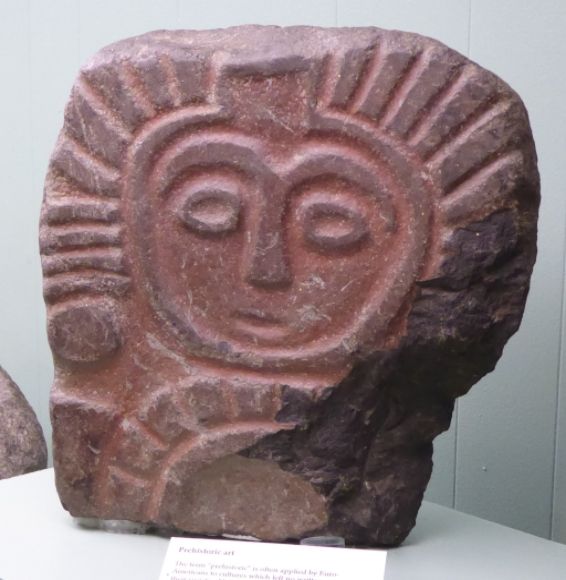 Shown above is an ancient stone carving on display in the Maryhill Museum of Art.
Shown above is an ancient stone carving on display in the Maryhill Museum of Art. 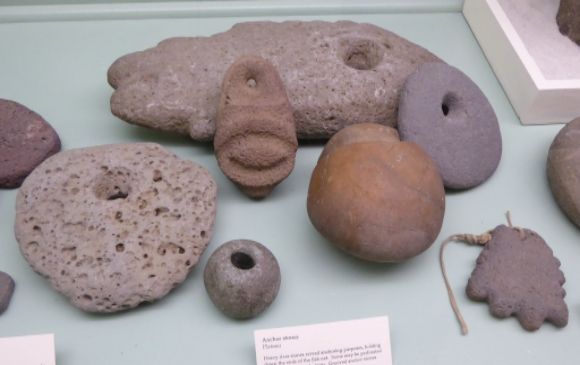 Shown above are some ancient stone artifacts on display in the Maryhill Museum of Art.
Shown above are some ancient stone artifacts on display in the Maryhill Museum of Art.
Lodges
The Plateau Indians used conical mat lodges. Lodgepole pine provided the framework which was then covered with tule mats.
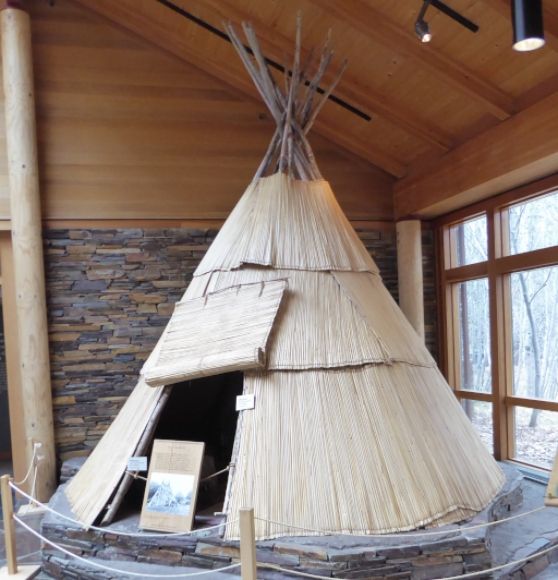 Shown above is a typical Plateau conical mat lodge on display in the High Desert Museum.
Shown above is a typical Plateau conical mat lodge on display in the High Desert Museum. 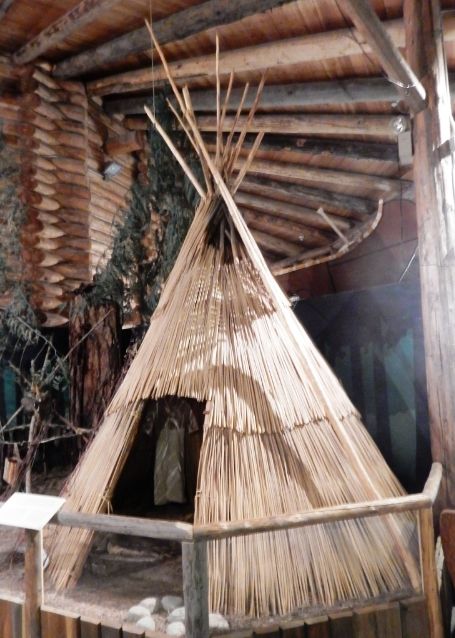 Shown above is a Kootenai mat lodge on display in the Heritage Museum in Libby, Montana. The Kootenai are not linguistically related to any other tribe.
Shown above is a Kootenai mat lodge on display in the Heritage Museum in Libby, Montana. The Kootenai are not linguistically related to any other tribe.
Basketry and Beadwork
The Plateau tribes are known for their fine basketry and beadwork. In his book Native American Clothing: An Illustrated History, Theodore Brasser writes:
“This was the ancient heartland of North American basketry, and the handiwork covered a range of objects from twined and coiled utilitarian containers to bags, baskets and hats decorated in various techniques.”
In her chapter in Woven History: Native American Basketry, Mary Dodds Schlick writes:
“The Native people of the Columbia Plateau are rich in basketmaking tradition. For thousands of years their ancestors have used the roots, bark and grasses of the region to fashion containers for all their needs. Today a small number of descendants of these basketmakers continue this ancient heritage, an art form known worldwide for fine craftsmanship, variety in design, and beauty.”
In their entry on Plateau basketry in the Handbook of North American Indians, Richard Conn and Mary Dodds Schlick write:
“Basketry is surely one of the most significant, and least appreciated, creative and technological achievements of the world’s peoples. Unlike the more-esteemed potters or beadworkers, basketmakers must create the basic form while simultaneously planning and placing the decoration correctly.”
Displays of Plateau basketry and beadwork are featured at many museums.
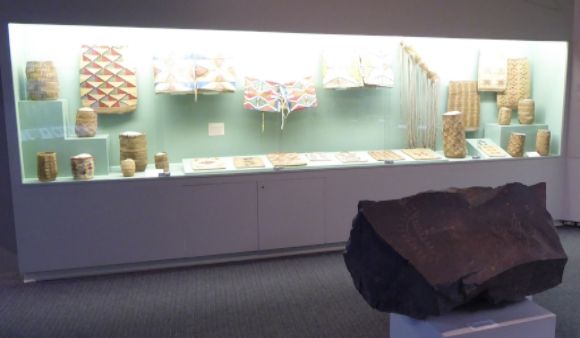 Shown above is the display of Plateau baskets and parfleches in the Maryhill Museum of Art. The basalt rock has a petroglyph which is often found along the Columbia River.
Shown above is the display of Plateau baskets and parfleches in the Maryhill Museum of Art. The basalt rock has a petroglyph which is often found along the Columbia River. 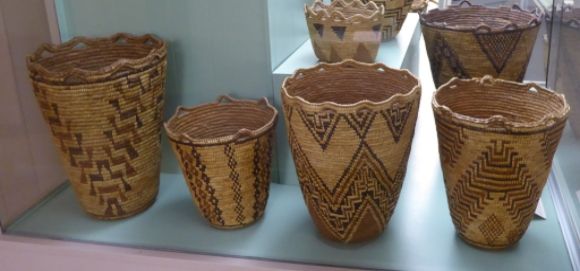 Shown above is another display of Plateau baskets in the Maryhill Museum of Art.
Shown above is another display of Plateau baskets in the Maryhill Museum of Art. 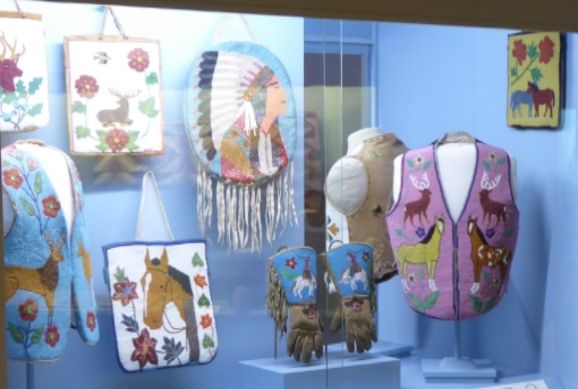 Two regional beadwork styles developed: one which used geometric designs and one which was figurative. Pictorial beadwork often utilized floral designs, horse imagery, and depictions of deer, elk, and birds. The beadwork shown above is on display in the Maryhill Museum of Art.
Two regional beadwork styles developed: one which used geometric designs and one which was figurative. Pictorial beadwork often utilized floral designs, horse imagery, and depictions of deer, elk, and birds. The beadwork shown above is on display in the Maryhill Museum of Art.  The man’s vest shown above was made about 1910. It is on display in the Maryhill Museum of Art.
The man’s vest shown above was made about 1910. It is on display in the Maryhill Museum of Art.  The beaded moccasins shown above are on display in the High Desert Museum.
The beaded moccasins shown above are on display in the High Desert Museum. 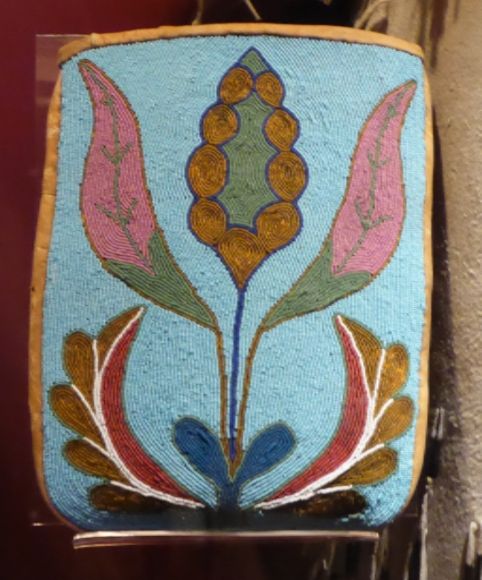 The beaded bag shown above ison display in the High Desert Museum.
The beaded bag shown above ison display in the High Desert Museum.
Basketry Hats
One of the distinctive characteristics of Plateau women’s dress is the basketry hat. This hat is usually described as being fez-shaped with designs woven it. In her book Columbia River Basketry: Gift of the Ancestors, Gift of the Earth, Mary Dodds Schlick reports:
“The graceful proportions of these hats and the varied execution of the traditional banded zigzag design required great skill on the part of the weaver.”
In their chapter on Plateau basketry in the Handbook of North American Indians, Richard Conn and Mary Dodds Schlick report:
“Most basket hats were made in the southern Plateau by the people who were settled on the Nez Perce, Umatilla, Warm Springs, and Yakima reservations and by the Joseph band of Nez Perce living on the Colville Reservation.”
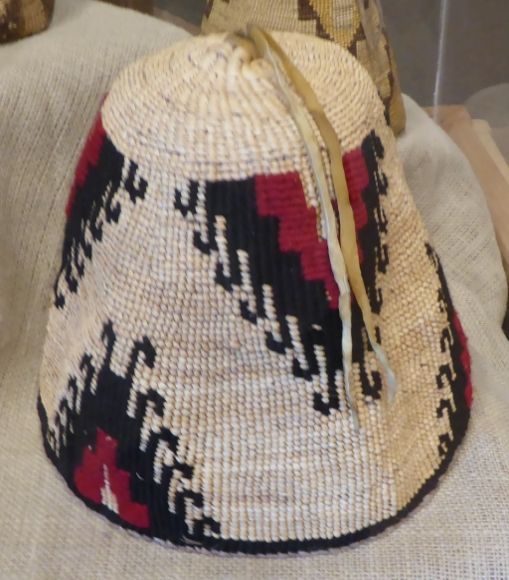 his beaded basketry hat is on display in the Columbia Gorge Discovery Center.
his beaded basketry hat is on display in the Columbia Gorge Discovery Center. 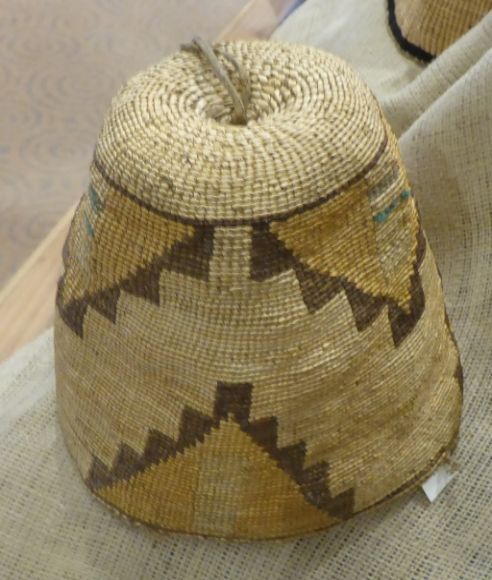 This basketry hat is on display in the Columbia Gorge Discovery Center.
This basketry hat is on display in the Columbia Gorge Discovery Center. 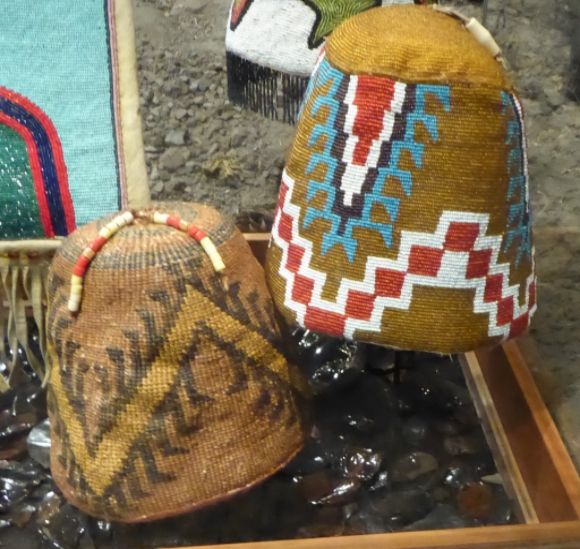 These hats are on display in the High Desert Museum.
These hats are on display in the High Desert Museum.
Women’s Dresses
With regard to women’s dress, Josephine Paterek, in her book Encyclopedia of American Indian Costume, reports:
“The earliest attire was a simple wraparound skirt and poncho top, both made of skin. Later they wore the strap-and-sleeve dress, and may have worn the side-seam dress.”
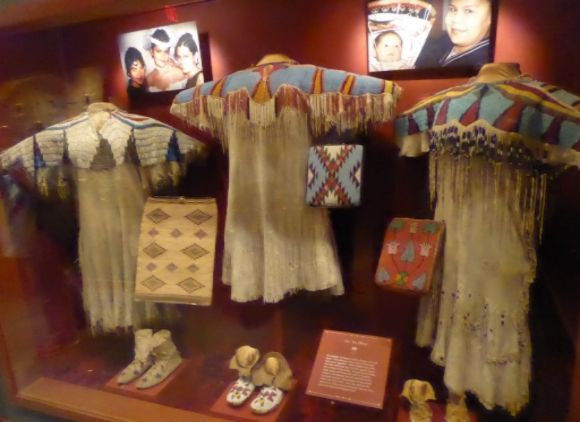 The dresses shown above are on display in the High Desert Museum.
The dresses shown above are on display in the High Desert Museum. 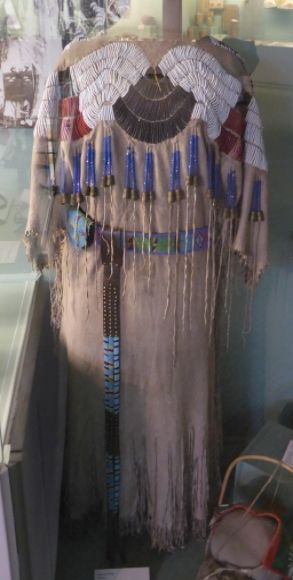 The dress shown above is on display in the Maryhill Museum of Art.
The dress shown above is on display in the Maryhill Museum of Art.

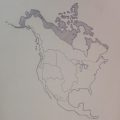
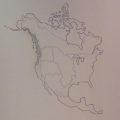

Leave a Reply